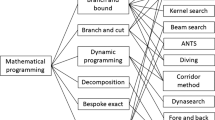Abstract
The general class of zero-order Global Optimization problems is split into subclasses according to a proposed “Complexity measure” and the computational complexity of each subclass is rigorously estimated. Then, the laboriousness (computational demand) of general Branch-and-Bound (BnB) methods is estimated for each subclass. For conventional “Cubic” BnB based on splitting an n-dimensional cube into \(2^n\) sub-cubes, both upper and lower laboriousness estimates are obtained. The value of the Complexity measure for a problem subclass enters linearly into all complexity and laboriousness estimates for that subclass. A new BnB method based on the lattice \(A_n^*\) is presented with upper laboriousness bound that is, though conservative, smaller by a factor of \(O((4/3)^n)\) than the lower bound of the conventional method. The optimality of the new method is discussed. All results are extended to the class of Adaptive Covering problems—that is, covering of a large n-dimensional set by balls of different size, where the size of each ball is defined by a locally computed criterion.






Similar content being viewed by others
References
Nemirovsky, A.S., Yudin, D.B.: Problem Complexity and Method Efficiency in Optimization. Wiley, New York (1983)
Nesterov, YuE, Nemirovskii, A.S.: Interior Point Polynomial Algorithms in Convex Programming. SIAM, Philadelphia (1994)
Floudas, C.A.: Deterministic Global Optimization. Theory, Methods and Applications. Kluwer, Dordr (2000)
Shor, N.Z.: Minimization Methods for Non-differentiable Functions. Springer, Berlin (1985)
Conway, J.H., Sloane, N.J.A.: Sphere Packings, Lattices and Groups. Springer, New York (1993)
Belitz, P., Bewley, T.: Efficient Derivative-Free Optimization. In: Proceedings of the 46th IEEE Conference on Decision and Control New Orleans, LA, USA, pp. 5358–5363. 12–14 Dec 2007
Booker, A., Dennis Jr., J., Frank, P., Serafini, D., Torczon, V., Trosset, M.: A rigorous framework for optimization of expensive functions by surrogates. Struct. Multidiscip. Optim. 17, 1–13 (1999)
Marsden, A.L., Wang, M., Dennis Jr., J.E., Moin, P.: Optimal aeroacoustic shape design using the surrogate management framework. Optim. Eng. 5, 235–262 (2004)
Charles, A., Dennis, J.J.R.: Mesh adaptive direct search algorithms for constrained optimization. SIAM J. Optim. 17, 2006–2029 (2004)
Coope, I.D., Price, C.J.: On the convergence of grid-based methods for unconstrained optimization. SIAM J. Optim. 11, 859–869 (2000)
Berger, M.J., Colella, P.: Local adaptive mesh refinement for shock hydrodynamics. J. Comput. Phys. 82, 64–84 (1989)
Ceniceros, H.D., Hou, T.Y.: An efficient dynamically adaptive mesh for potentially singular solutions. J. Comput. Phys. 172, 609–639 (2001)
Henk J.: Integration over two-dimensional Brillouin zones by adaptive mesh refinement. Phys. Rev. B 64, article 035412
Li, X., Ramanathan, S., Parashar, M.: Hierarchical partitioning techniques for structured adaptive mesh refinement (SAMR) applications. In: Proceedings of International Conference on Parallel Processing, Vancouver, BC, Canada, pp. 336–343 (2002). 20–23 Aug 2002
Heinkenschloss, M., Herty, M.: A spatial domain decomposition method for parabolic optimal control problems. J. Comput. Appl. Math. 201, 88–111 (2007)
Kiseleva, E., Stepanchuk, T.: On the efficiency of a global non-differentiable optimization algorithm based on the method of optimal set partitioning. J. Glob. Optim. 25, 209–235 (2003)
Abramowitz, M., Stegun, I.A. (eds.).: Handbook of Mathematical Functions with Formulas, Graphs, and Mathematical Tables, 470 pp. Dover Publications, N.Y. (1972)
Gradshteyn, I.S., Ryzhik, I.M.: Table of Integrals, Series, and Products. Elsevier, Amsterdam (2007)
Sels, V., et al.: Hybrid tabu search and a truncated branch-and-bound for the unrelated parallel machine scheduling problem. Comput. Oper. Res. 53, 107–117 (2015)
Franck, B., Neumann, K., Schwindt, C.: Truncated branch-and-bound, schedule-construction, and schedule-improvement procedures for resource-constrained project scheduling. OR Spektrum 23, 297–324 (2001)
Constales, D.: The volume of the intersection of a cube and a ball in N-space. In: Constales, D. (ed.) Problems and Solutions, Problem 96-19, vol. 39, pp. 783–786. SIAM Review (1997)
Flum, J., Grohe, M.: Parameterized Complexity Theory. Springer, New York (2006)
McKilliam R.G., Clarkson I.V.L., Smith W.D., Quinn B.G.: A linear time nearest point algorithm for the lattice \(A_n^*\), International Symposium on Information Theory and Its Applications (ISITA 2008), Auckland, Australia, pp. 1–5. 7–10 Dec 2008
McKilliam, R.G., Clarkson, I.V.L., Quinn, B.G.: An algorithm to compute the nearest point in the lattice \(A_n^*\). IEEE Trans. Inf. Theory 54, 4378–4381 (2008)
Acknowledgments
This material is based in part on research supported by Air Force Research Laboratory (AFRL) and the Defense Advanced Research Projects Agency (DARPA) under agreement number FA8650-11-1-7150. The U.S. Government is authorized to reproduce and distribute reprints for Governmental purposes notwithstanding any copyright notation thereon. The views and conclusions contained herein are those of the authors and should not be interpreted as necessarily representing the official policies or endorsements, either expressed or implied, of the Air Force Research Laboratory (AFRL) and the Defense Advanced Research Projects Agency (DARPA) or the U.S. Government. The first author expresses his deep appreciation to Prof. Sergey Gusev and Prof. Arkadii Nemirovskii who many years ago encouraged him to work on this problem.
Author information
Authors and Affiliations
Corresponding author
Rights and permissions
About this article
Cite this article
Shishkin, S.L., Finn, A.M. An optimal algorithm for Global Optimization and adaptive covering. J Glob Optim 66, 535–572 (2016). https://doi.org/10.1007/s10898-016-0416-6
Received:
Accepted:
Published:
Issue Date:
DOI: https://doi.org/10.1007/s10898-016-0416-6




